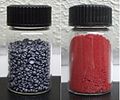(2005). "Neon". Radiogenic isotope geology. Cambridge University Press. p. 303. ISBN 978-0-521-82316-6. Resources on Isotopes Periodic Table—Neon at the...
32 KB (3,820 words) - 21:12, 28 May 2024
Plutonium (section Isotopes and nucleosynthesis)
isotopes of plutonium range in mass number from 228 to 247. The primary decay modes of isotopes with mass numbers lower than the most stable isotope,...
141 KB (15,142 words) - 23:03, 18 May 2024
Praseodymium (section Isotopes)
isotopes lighter than 141Pr is positron emission or electron capture to isotopes of cerium, while that of heavier isotopes is beta decay to isotopes of...
37 KB (4,819 words) - 02:06, 4 May 2024





























